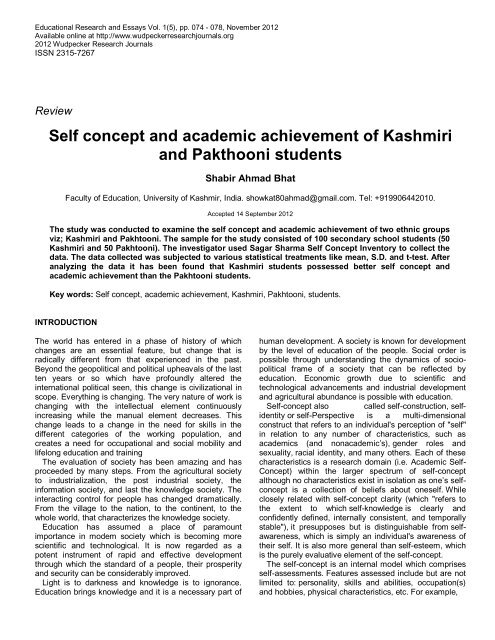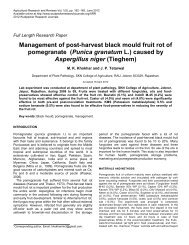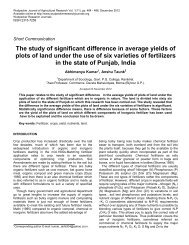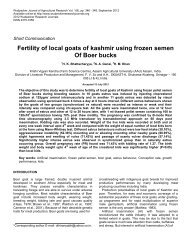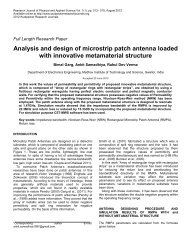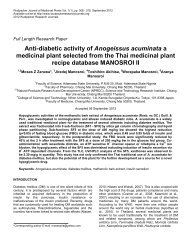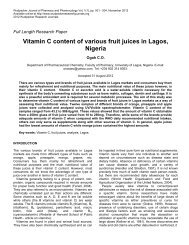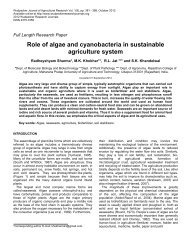Self concept and academic achievement of Kashmiri and Pakthooni ...
Self concept and academic achievement of Kashmiri and Pakthooni ...
Self concept and academic achievement of Kashmiri and Pakthooni ...
Create successful ePaper yourself
Turn your PDF publications into a flip-book with our unique Google optimized e-Paper software.
Educational Research <strong>and</strong> Essays Vol. 1(5), pp. 074 - 078, November 2012<br />
Available online at http://www.wudpeckerresearchjournals.org<br />
2012 Wudpecker Research Journals<br />
ISSN 2315-7267<br />
Review<br />
<strong>Self</strong> <strong>concept</strong> <strong>and</strong> <strong>academic</strong> <strong>achievement</strong> <strong>of</strong> <strong>Kashmiri</strong><br />
<strong>and</strong> <strong>Pakthooni</strong> students<br />
Shabir Ahmad Bhat<br />
Faculty <strong>of</strong> Education, University <strong>of</strong> Kashmir, India. showkat80ahmad@gmail.com. Tel: +919906442010.<br />
Accepted 14 September 2012<br />
The study was conducted to examine the self <strong>concept</strong> <strong>and</strong> <strong>academic</strong> <strong>achievement</strong> <strong>of</strong> two ethnic groups<br />
viz; <strong>Kashmiri</strong> <strong>and</strong> Pakhtooni. The sample for the study consisted <strong>of</strong> 100 secondary school students (50<br />
<strong>Kashmiri</strong> <strong>and</strong> 50 Pakhtooni). The investigator used Sagar Sharma <strong>Self</strong> Concept Inventory to collect the<br />
data. The data collected was subjected to various statistical treatments like mean, S.D. <strong>and</strong> t-test. After<br />
analyzing the data it has been found that <strong>Kashmiri</strong> students possessed better self <strong>concept</strong> <strong>and</strong><br />
<strong>academic</strong> <strong>achievement</strong> than the Pakhtooni students.<br />
Key words: <strong>Self</strong> <strong>concept</strong>, <strong>academic</strong> <strong>achievement</strong>, <strong>Kashmiri</strong>, Pakhtooni, students.<br />
INTRODUCTION<br />
The world has entered in a phase <strong>of</strong> history <strong>of</strong> which<br />
changes are an essential feature, but change that is<br />
radically different from that experienced in the past.<br />
Beyond the geopolitical <strong>and</strong> political upheavals <strong>of</strong> the last<br />
ten years or so which have pr<strong>of</strong>oundly altered the<br />
international political seen, this change is civilizational in<br />
scope. Everything is changing. The very nature <strong>of</strong> work is<br />
changing with the intellectual element continuously<br />
increasing while the manual element decreases. This<br />
change leads to a change in the need for skills in the<br />
different categories <strong>of</strong> the working population, <strong>and</strong><br />
creates a need for occupational <strong>and</strong> social mobility <strong>and</strong><br />
lifelong education <strong>and</strong> training<br />
The evaluation <strong>of</strong> society has been amazing <strong>and</strong> has<br />
proceeded by many steps. From the agricultural society<br />
to industrialization, the post industrial society, the<br />
information society, <strong>and</strong> last the knowledge society. The<br />
interacting control for people has changed dramatically.<br />
From the village to the nation, to the continent, to the<br />
whole world, that characterizes the knowledge society.<br />
Education has assumed a place <strong>of</strong> paramount<br />
importance in modem society which is becoming more<br />
scientific <strong>and</strong> technological. It is now regarded as a<br />
potent instrument <strong>of</strong> rapid <strong>and</strong> effective development<br />
through which the st<strong>and</strong>ard <strong>of</strong> a people, their prosperity<br />
<strong>and</strong> security can be considerably improved.<br />
Light is to darkness <strong>and</strong> knowledge is to ignorance.<br />
Education brings knowledge <strong>and</strong> it is a necessary part <strong>of</strong><br />
human development. A society is known for development<br />
by the level <strong>of</strong> education <strong>of</strong> the people. Social order is<br />
possible through underst<strong>and</strong>ing the dynamics <strong>of</strong> sociopolitical<br />
frame <strong>of</strong> a society that can be reflected by<br />
education. Economic growth due to scientific <strong>and</strong><br />
technological advancements <strong>and</strong> industrial development<br />
<strong>and</strong> agricultural abundance is possible with education.<br />
<strong>Self</strong>-<strong>concept</strong> also called self-construction, selfidentity<br />
or self-Perspective is a multi-dimensional<br />
construct that refers to an individual's perception <strong>of</strong> "self"<br />
in relation to any number <strong>of</strong> characteristics, such as<br />
<strong>academic</strong>s (<strong>and</strong> non<strong>academic</strong>’s), gender roles <strong>and</strong><br />
sexuality, racial identity, <strong>and</strong> many others. Each <strong>of</strong> these<br />
characteristics is a research domain (i.e. Academic <strong>Self</strong>-<br />
Concept) within the larger spectrum <strong>of</strong> self-<strong>concept</strong><br />
although no characteristics exist in isolation as one’s self<strong>concept</strong><br />
is a collection <strong>of</strong> beliefs about oneself. While<br />
closely related with self-<strong>concept</strong> clarity (which "refers to<br />
the extent to which self-knowledge is clearly <strong>and</strong><br />
confidently defined, internally consistent, <strong>and</strong> temporally<br />
stable"), it presupposes but is distinguishable from selfawareness,<br />
which is simply an individual's awareness <strong>of</strong><br />
their self. It is also more general than self-esteem, which<br />
is the purely evaluative element <strong>of</strong> the self-<strong>concept</strong>.<br />
The self-<strong>concept</strong> is an internal model which comprises<br />
self-assessments. Features assessed include but are not<br />
limited to: personality, skills <strong>and</strong> abilities, occupation(s)<br />
<strong>and</strong> hobbies, physical characteristics, etc. For example,
75 Wudpecker J. Edu. Res.<br />
the statement "I am lazy" is a self-assessment that<br />
contributes to the self-<strong>concept</strong>. However, the statement "I<br />
am tired" would not be part <strong>of</strong> someone's self-<strong>concept</strong>,<br />
since being tired is a temporary state <strong>and</strong> a more<br />
objective judgment. A person's self-<strong>concept</strong> may change<br />
with time as reassessment occurs, which in extreme<br />
cases can lead to identity crises.<br />
The Afghans came to the valley <strong>of</strong> Kashmir 200 - 250<br />
years ago. A sizeable number <strong>of</strong> them came to India<br />
before <strong>and</strong> during the Mughal rule <strong>and</strong> entered Kashmir<br />
during time <strong>of</strong> Ahmad Shah Durrani, around A. D. 1753.<br />
They belong to various clans <strong>and</strong> had settled in different<br />
parts <strong>of</strong> the valley. The prominent Afghan clans <strong>of</strong> the<br />
present day, Kashmir are Yousuf Zai, Khankal, Afridi,<br />
Swati Malik, Durrani <strong>and</strong> Qais. They are popularly known<br />
as Khans by the local population, but they prefer to be<br />
known as Pakhtoons. Over a period <strong>of</strong> time, various<br />
batches <strong>of</strong> Immigrant Afghans settled in the upper<br />
reaches <strong>of</strong> the valley <strong>of</strong> Kashmir with a view to occupy<br />
the virgin l<strong>and</strong>s with abundance <strong>of</strong> water. Now the Afghan<br />
settlements have grown in size <strong>and</strong> have become fullfledged<br />
state subjects since 1947. The Afghans<br />
(Pakhtoons), especially in rural areas, still maintain their<br />
indigenous identity.<br />
The Afghans (Pakhtoons) initially came to Kashmir<br />
during the time <strong>of</strong> Ahmad Shah Durraini, <strong>and</strong> thereafter<br />
in batches due to intertribal feudes in their home l<strong>and</strong><br />
creating insecure conditions. Later on it was Maharaja<br />
Gulab Singh, the Ruler <strong>of</strong> Kashmir, who <strong>of</strong>fered them<br />
employment, opportunities, especially for guarding the<br />
frontiers <strong>and</strong> granted them l<strong>and</strong> <strong>and</strong> Jagirs <strong>and</strong> allowed<br />
them to settle in colonies <strong>of</strong> their choice.<br />
Objectives <strong>of</strong> the study<br />
The following objectives has been formulated for the<br />
present investigation.<br />
1. To study <strong>Self</strong>-Concept <strong>of</strong> <strong>Kashmiri</strong> <strong>and</strong> Pakhtooni<br />
students.<br />
2. To study the Academic Achievement <strong>of</strong> <strong>Kashmiri</strong><br />
<strong>and</strong> Pakhtooni Students.<br />
3. To Compare <strong>Kashmiri</strong> <strong>and</strong> Pakhtooni Students<br />
on self <strong>concept</strong>.<br />
4. To compare <strong>Kashmiri</strong> <strong>and</strong> Pakhtooni Students on<br />
<strong>academic</strong> <strong>achievement</strong>.<br />
Hypotheses<br />
The following hypotheses were formulated for the present<br />
investigation.<br />
1. There is significant difference between <strong>Kashmiri</strong><br />
<strong>and</strong> Pakhtooni Students on <strong>Self</strong>-Concept.<br />
2. There is significant difference between <strong>Kashmiri</strong><br />
<strong>and</strong> Pakhtooni Students on Academic Achievement.<br />
Sample<br />
The sample for the present study consisted <strong>of</strong> 100 secondary<br />
school students (50 <strong>Kashmiri</strong> <strong>and</strong> 50 Pakhtooni) selected<br />
r<strong>and</strong>omly from the different schools <strong>of</strong> district G<strong>and</strong>erbal (Table<br />
1).<br />
TOOLS USED<br />
The data for the present study was collected with the help<br />
<strong>of</strong> the self <strong>concept</strong> inventory (Real <strong>Self</strong> <strong>and</strong> Ideal <strong>Self</strong>) by<br />
Sagar <strong>and</strong> Sharma.<br />
PROCEDURE<br />
In order to collect the information the investigator visited<br />
various secondary school students <strong>of</strong> district G<strong>and</strong>erbal. The<br />
investigator administered mental health battery to 100<br />
students (50 <strong>Kashmiri</strong> <strong>and</strong> 50 Pakhtooni students) pursuing<br />
their education in different schools <strong>of</strong> district G<strong>and</strong>erbal to<br />
assess their self <strong>concept</strong> <strong>and</strong> <strong>academic</strong> <strong>achievement</strong>.<br />
The <strong>academic</strong> <strong>achievement</strong> <strong>of</strong> previous two years <strong>of</strong> the<br />
sample subjects were collected from the <strong>of</strong>ficial<br />
records <strong>of</strong> the respective schools.<br />
Statistical treatment<br />
The data collected was subjected to the following<br />
statistical treatment.<br />
Mean, S.D, t-test.<br />
ANALYSIS AND INTERPRETATION OF THE DATA<br />
The table 1.1 shows the mean comparison <strong>of</strong> <strong>Kashmiri</strong><br />
<strong>and</strong> Pakhtooni school students on Ideal self dimension <strong>of</strong><br />
self <strong>concept</strong> inventory. The calculated t-value (3.37) is<br />
greater than the tabulated t-value at 0.01 level <strong>of</strong><br />
significance, which depicts that there is significance<br />
difference between <strong>Kashmiri</strong> <strong>and</strong> Pakhtooni students on<br />
Ideal self <strong>of</strong> <strong>Self</strong> <strong>concept</strong> inventory. The above result<br />
clarifies that <strong>Kashmiri</strong> students have better Ideal self<br />
than Pakhtooni Students<br />
The table 1.2 shows the mean comparison <strong>of</strong> <strong>Kashmiri</strong><br />
<strong>and</strong> Pakhtooni school students on real self dimension <strong>of</strong><br />
self <strong>concept</strong> inventory. The calculated t-value (4.5) is<br />
greater than the tabulated t-value at 0.01 level <strong>of</strong><br />
significance, which depicts that there is significance<br />
difference between <strong>Kashmiri</strong> <strong>and</strong> Pakhtooni students on<br />
Real self <strong>of</strong> <strong>Self</strong> <strong>concept</strong> inventory. The above result<br />
clarifies that <strong>Kashmiri</strong> students have better Real self than<br />
Pakhtooni Students.<br />
Table 1.3 shows the mean comparison <strong>of</strong> <strong>Kashmiri</strong> <strong>and</strong><br />
Pakhtooni school students on <strong>Self</strong> Concept inventory.<br />
The calculated t-value (3.94) is greater than the tabulated
169<br />
168<br />
167<br />
166<br />
165<br />
164<br />
163<br />
162<br />
Table 1:The breakup <strong>of</strong> the sample are as under:<br />
Group N Total<br />
<strong>Kashmiri</strong> Students 50 50<br />
Pakhtooni Students 50 50<br />
Total 100<br />
Table 1.1: Showing the mean comparison <strong>of</strong> <strong>Kashmiri</strong> <strong>and</strong> Pakhtooni<br />
Students on Ideal <strong>Self</strong> Dimension <strong>of</strong> <strong>Self</strong> <strong>concept</strong> (N= 50 in each group).<br />
Group<br />
<strong>Kashmiri</strong><br />
Pakhtooni<br />
N<br />
50<br />
50<br />
Mean<br />
165<br />
162<br />
S.D<br />
5.4<br />
3.2<br />
t- value<br />
3.37<br />
Level <strong>of</strong> Significance<br />
Significant at 0.01 Level<br />
Table 1.2: Showing the mean comparison <strong>of</strong> <strong>Kashmiri</strong> <strong>and</strong> Pakhtooni<br />
Students on Real <strong>Self</strong> Dimension <strong>of</strong> <strong>Self</strong> <strong>concept</strong> Inventory (N= 50 in each<br />
group).<br />
Group<br />
<strong>Kashmiri</strong><br />
Pakhtooni<br />
N<br />
50<br />
50<br />
Mean<br />
167<br />
163<br />
S.D<br />
4.47<br />
4.40<br />
t- value<br />
4.5<br />
Level <strong>of</strong> Significance<br />
Significant at 0.01 Level<br />
Table 1.3: Showing the mean comparison <strong>of</strong> <strong>Kashmiri</strong> <strong>and</strong> Pakhtooni<br />
Students on <strong>Self</strong> <strong>concept</strong> (N= 50 in each group).<br />
Group<br />
<strong>Kashmiri</strong><br />
Pakhtooni<br />
N<br />
50<br />
50<br />
168<br />
Mean<br />
168<br />
164.5<br />
S.D<br />
4.816<br />
4.024<br />
Figure 1. Mean comparison on self <strong>concept</strong>.<br />
t- value<br />
3.94<br />
Level <strong>of</strong> Significance<br />
Significant at 0.01 Level<br />
164.5<br />
<strong>Kashmiri</strong> Pakhtooni<br />
Mean<br />
Bhat 76
77 Wudpecker J. Edu. Res.<br />
Table 1.4: Showing the mean comparison <strong>of</strong> <strong>Kashmiri</strong> <strong>and</strong> Pakhtooni<br />
students on <strong>academic</strong> Achievement (N= 50 in each group).<br />
Group<br />
<strong>Kashmiri</strong><br />
Pakhtooni<br />
N<br />
50<br />
50<br />
Mean<br />
57.06<br />
46.01<br />
S.D<br />
7.8<br />
6.25<br />
t-value<br />
7.81<br />
Figure 2. Mean comparison on <strong>academic</strong> achivement.<br />
t-value at 0.01 level <strong>of</strong> significance, which depicts that<br />
there is significance difference between <strong>Kashmiri</strong> <strong>and</strong><br />
Pakhtooni students on <strong>Self</strong> Concept Inventory. The<br />
above result clarifies that <strong>Kashmiri</strong> students have better<br />
<strong>Self</strong> Concept than Pakhtooni Students.<br />
In the light <strong>of</strong> above results, the hypotheses No. 1<br />
which reads as “There is significant difference between<br />
<strong>Kashmiri</strong> <strong>and</strong> Pakhtooni students on self <strong>concept</strong>” st<strong>and</strong>s<br />
accepted. (Figure 1)<br />
The table 1.4 shows the mean comparison <strong>of</strong> <strong>Kashmiri</strong><br />
<strong>and</strong> Pakhtooni students on <strong>academic</strong> <strong>achievement</strong>. The<br />
calculated t- value (7.81) is greater than the tabulated t-<br />
value <strong>and</strong> the difference was found to be significant at<br />
0.01 level. The above table revels that the <strong>Kashmiri</strong><br />
students show better <strong>academic</strong> <strong>achievement</strong> than the<br />
Pakhtooni Students.<br />
In light <strong>of</strong> the above discussion, the hypotheses No.2<br />
which reads as, “There is a significant difference between<br />
<strong>Kashmiri</strong> <strong>and</strong> Pakhtooni students on Academic<br />
<strong>achievement</strong>” st<strong>and</strong>s accepted. (Figure 2).<br />
MAJOR FINDINGS<br />
60<br />
50<br />
40<br />
30<br />
20<br />
10<br />
0<br />
57.06<br />
The following are some <strong>of</strong> the conclusions drawn from the<br />
present study.<br />
Level <strong>of</strong> significance<br />
0.01 Level<br />
46.01<br />
<strong>Kashmiri</strong> Pakhtooni<br />
1. It has been found that <strong>Kashmiri</strong> <strong>and</strong> Pakhtooni<br />
students differ significantly on ideal self dimension <strong>of</strong> <strong>Self</strong><br />
Concept inventory. The <strong>Kashmiri</strong> students were found to have<br />
better ideal self than the Pakhtooni students.<br />
2. It has been found that <strong>Kashmiri</strong> <strong>and</strong> Pakhtooni<br />
students differ significantly on real self dimension <strong>of</strong> <strong>Self</strong><br />
Concept Inventory. The <strong>Kashmiri</strong> students were found to have<br />
better real self than Pakhtooni students.<br />
3. It has been found that <strong>Kashmiri</strong> <strong>and</strong> Pakhtooni<br />
students differ significantly on overall dimensions <strong>of</strong> <strong>Self</strong><br />
Concept Inventory. The <strong>Kashmiri</strong> students were found have<br />
better self <strong>concept</strong> than the Pakhtooni students.<br />
4. It has been found that <strong>Kashmiri</strong> <strong>and</strong> Pakhtooni<br />
students differ significant on <strong>academic</strong> <strong>achievement</strong>.<br />
<strong>Kashmiri</strong> secondary students were found to have better<br />
<strong>academic</strong> <strong>achievement</strong> than Pakhtooni students.<br />
REFERENCES<br />
Mean<br />
Agarwal A (2002). Study <strong>of</strong> Relationship <strong>of</strong> Academic Achievements <strong>of</strong><br />
Boys <strong>and</strong> Girls with <strong>Self</strong>-Concept <strong>and</strong> Level <strong>of</strong> Aspiration, Indian J.<br />
Edu. Res., 21: 75-76.<br />
Anderson (2004). Psychology <strong>of</strong> Physically H<strong>and</strong>icapped children, Lond<br />
MacMilan.<br />
Bala M (1995). A Comparative Study <strong>of</strong> self <strong>concept</strong> <strong>of</strong> Deaf Children.<br />
Cited in Fourth Survey <strong>of</strong> Research in Education, New Delhi, NCERT.<br />
Banui Kuotsu (1992). A study <strong>of</strong> the Value’s <strong>of</strong> College Students in
Nagal<strong>and</strong> in Relation to their <strong>Self</strong>-<strong>concept</strong>, fifth survey <strong>of</strong> Educational<br />
Research; New Delhi, NCERT.<br />
Bhargava M, Shah MA (1971). Manual for Level <strong>of</strong> Aspiration, National<br />
Psychological Corporation – Agra.<br />
Borg WR, Call MD (1979). Study <strong>of</strong> <strong>Self</strong>-<strong>concept</strong> <strong>and</strong> Level <strong>of</strong> Aspiration<br />
<strong>of</strong> H<strong>and</strong>icapped Children Educational Research – An Introduction:<br />
New York. Longman Co. 444-470.<br />
Kumthekar M (2004). A Comparative Analysis <strong>of</strong> Physically Challenged<br />
<strong>and</strong> Normal College going Students on <strong>Self</strong>-<strong>concept</strong> <strong>and</strong> Mental<br />
Health, Journal <strong>of</strong> Health Management, Vol. 7, No. 424.<br />
Metha, (2007) Academic Achievement. In Neil Davison (Ed). General<br />
Psychology (6 th Edition), New Delhi: Tata McGrawhill pp 538-39.<br />
Nirmani Mohammad, Tavakko Mousazadeh Comparative study <strong>of</strong> <strong>Self</strong>esteem<br />
<strong>and</strong> <strong>Self</strong>-<strong>concept</strong> <strong>of</strong> H<strong>and</strong>icapped <strong>and</strong> Normal Students. J.<br />
Behaioural Psychol., 9: 308.<br />
Peterson R (2001). A Study <strong>of</strong> <strong>Self</strong> Concept, Stress <strong>and</strong> Level <strong>of</strong><br />
Aspiration <strong>of</strong> H<strong>and</strong>icapped <strong>and</strong> Normal Teenagers in Newzeal<strong>and</strong>. J.<br />
Behavoural Psychol., 3: 325.<br />
R. K. & Sharma, S. (2004) A Study <strong>of</strong> Level <strong>of</strong> Aspiration Academic<br />
Achievement <strong>and</strong> <strong>Self</strong>-<strong>concept</strong> <strong>of</strong> Secondary School Students in<br />
Eastern Zone <strong>of</strong> Nagal<strong>and</strong>, Current Research Journal, Vol. 18, No.<br />
414.<br />
Rainer, S. & Martin, P. (2000) A Study <strong>of</strong> <strong>Self</strong>-Concept, Stress <strong>and</strong><br />
Academic Achievement <strong>of</strong> Secondary School Students in West Zone<br />
<strong>of</strong> Assam, Journal <strong>of</strong> International Psychology, Vol. 2, No. 168.<br />
Rakish Ch<strong>and</strong>ra & Kabire Koul (2006) Comparative Analysis <strong>of</strong> Visually<br />
Impaired <strong>and</strong> Orthopedically H<strong>and</strong>icapped Children on Academic<br />
Performance, Level <strong>of</strong> Education, Level <strong>of</strong> Aspiration in Northern<br />
Assam. Cited in 3 rd Survey <strong>of</strong> Research on Education, New Delhi<br />
NCERT.<br />
Bhat 78<br />
Ratan, Lal Munpreet, Koul (2001) Comparative Study <strong>of</strong> <strong>Self</strong> Concept,<br />
Level <strong>of</strong> Aspiration <strong>and</strong> Mental Health <strong>of</strong> Hearing Impaired <strong>and</strong><br />
Visually Impaired Youth in Eastern Punjab. National. Journal <strong>of</strong><br />
Psychology, Vol. 7, No. 305.<br />
Reyes, O. (1999) Career Aspirations <strong>of</strong> Urban, Mexican American<br />
Adolescent Females. Hispanic Journal <strong>of</strong> Behavioral Sciences, Vol.<br />
21, No.3, 366-382, DOI: 10.1177/0738913010, SAGE Publications.<br />
Rohiee Jan, (2001) Parentally Accepted <strong>and</strong> Rejected Girls Children in<br />
relation to their Adjustment, <strong>Self</strong> Concept <strong>and</strong> Academic<br />
Achievement. Ph.D. Dissertation, Department <strong>of</strong> Education university<br />
<strong>of</strong> Kashmir.<br />
Shukla, S. & Ausman, M. (2003) Comparative Analysis <strong>of</strong> Hearing<br />
Impaired <strong>and</strong> Visually Impaired Children in Academic Potential <strong>and</strong><br />
its Relation with <strong>Self</strong> Concept in U. P. Journal <strong>of</strong> Applied Research in<br />
Education, Vol. 35, No., 22.<br />
Trow, (2004) Academic Achievement. In D<strong>and</strong>apani (Ed.). A Text Book<br />
<strong>of</strong> Advanced Educational Psychology (2 nd Edition), New Delhi:<br />
Atlantic Publishers pp 434.<br />
Verma, B. P. (1998) Personality Traits <strong>and</strong> need as Correlates <strong>of</strong><br />
Academic Achievement. Indian, Journal <strong>of</strong> Psychology <strong>and</strong> Education<br />
1998, 29 (1).<br />
Virginice Maclaren Murry Haight (2007) Level <strong>of</strong> Aspiration in Relation<br />
to Physical <strong>Self</strong>, Real <strong>Self</strong> <strong>and</strong> Ideal <strong>Self</strong> Among Lame <strong>and</strong> Visually<br />
Impaired Students in Vietnam. International Journal <strong>of</strong> Psychology,<br />
Vol. 6 th , No. 5.


